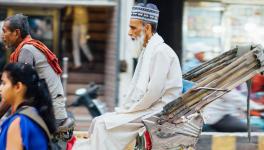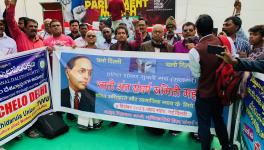From Royal Ironsmiths to Homeless Nomads, Gadia Lohars’ Decline Has Been Drastic
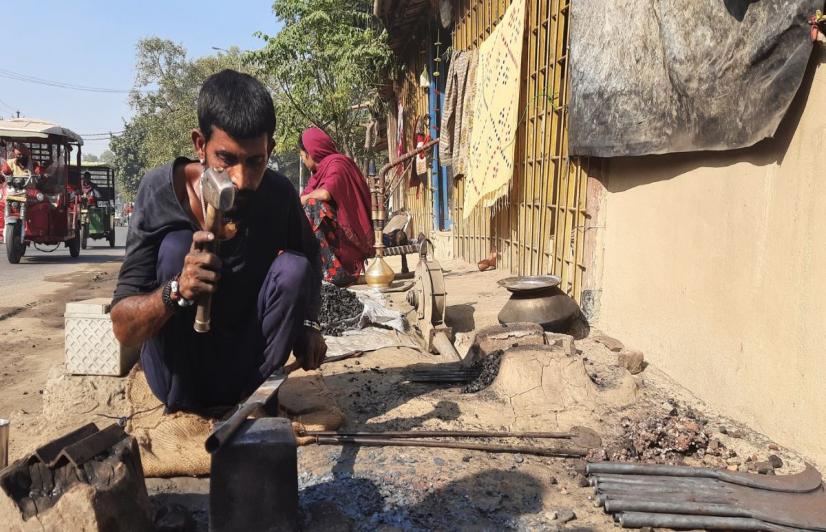
Gadia Lohar moulding a spade by the roadside (Photo - Musheera Ashraf, 101Reporters)
Saharanpur: As the sun’s rays break through the foggy morning, Sarla (40), a mother of five, carries some iron utensils, which she hopes to sell door-to-door. Made by her husband, she has chosen a kadai (a wide, round iron utensil) and two other large vessels. For 30 years now, this is the only life Sarla has ever known, save for when she has fallen ill or was asked by her husband to stay home.
Sarla resides with her family in a small, makeshift settlement of the Gadia Lohar community by the roadside in Saharanpur. Gadia Lohar women traditionally go door-to-door, selling metal goods crafted by their husbands. Hailing from Rajasthan, the ironsmiths lead a nomadic life, their bullock carts serving as mobile homes. Hence the name Gadia Lohar (Gadia means 'cart' in Hindi). Present in many states of India, the Gadia Lohars are known by different names in each region. In Rajasthan, they are called Gadulia Lohar, while in Madhya Pradesh, Delhi, Maharashtra, Uttar Pradesh and Haryana, they are known as Gaddi Lohar, Bhuvariya or Gadia and Bhubalia Lohar, respectively. Although their mother tongue is Mewari, they are fluent in Hindi.
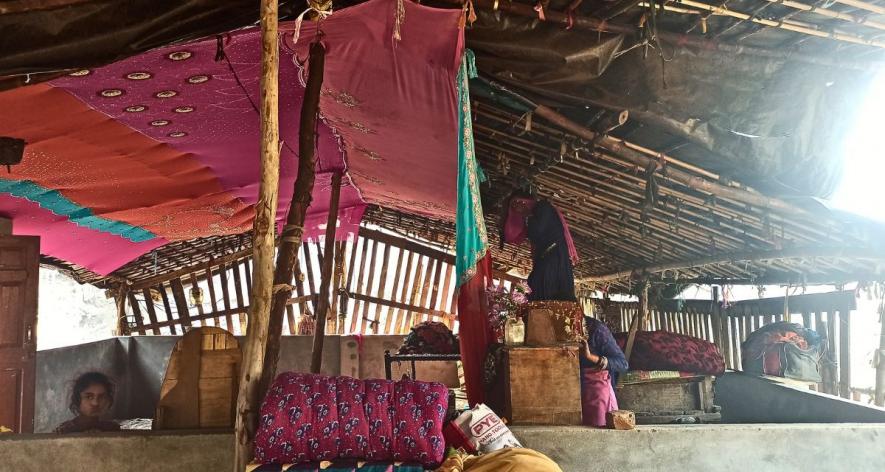
Gadia Lohars decorate their makeshift home with old sarees (Photo - Musheera Ashraf, 101Reporters)
No solution to caste debate
There are many such settlements across the states. The ambiguity in the status of their caste means they have no caste certificates, leaving them unable to avail the benefits of schemes designed for marginalised communities. Unlike many other nomadic tribes who are considered ‘Scheduled Tribes’ in most states, Gadia Lohars are categorised as an ‘Other Backward Class’ (OBC).
In Rajasthan, the Gadia Lohars come under the category of ‘Most Backward Class’ (MBC) and are entitled to a reservation of one per cent for government jobs. In Delhi, though the Gadia Lohars are categorised as OBC, they have not benefited from this categorisation and are not able to avail themselves of any special schemes despite their extreme marginalisation. No special schemes have been proposed or implemented for the Gadia Lohars living in Uttar Pradesh.
Proud of their Rajput heritage, they are unwilling to compromise on their identity. Sarla points to a metal sign that reads ‘Maharana Pratap Colony’ and states, “We want this settlement to be converted into a colony where we can build our houses without interference.”
A few metres away from her makeshift hut, Bundo Devi (60) sits on a cot while sewing a blanket. Community members seek Bundo’s advice on matters such as marriage and other major life decisions. She proudly shares the origins of her Rajput community. "We won’t compromise on our identity for caste certificates. Being Rajput is an honour for us,” Bundo says determinedly.
At the edge of the settlement, which accommodates around 40 families, Ramesh Kumar (44), a man with a handlebar moustache, sits, smoking a hookah. As pradhan or chief of the Gadia Lohar settlement near Beri Bagh, Saharanpur, for the past 12 years, Ramesh is a respected figure in the area. The pradhan is selected by mutual consent of the community.
Ramesh believes that the absence of a caste certificate is the reason the community remains unable to access basic services. “We are Rajputs,” he too states like the others, “and the government does not have any criteria to help people without seeing their caste certificates.” His ancestors left Rajasthan years ago. He has no certificates to prove his citizenship. Already struggling to acquire a permanent area to live in, he opines that the recently introduced Citizenship Amendment Act will impact the community negatively.
Ancestral oath kept alive.
Sarla tells 101Reporters that the Gadia Lohars served as blacksmiths in Maharana Pratap's army in Mewar. The 13th king of Mewar, he was revered for putting up a strong fight against the onslaught by the Mughals in the northwestern region of Rajasthan. When Mewar fell to the Mughals, the Gadia Lohar community vowed to the king that they would never return or settle elsewhere until his reign was restored. They then took to travelling across India by bullock cart, crafting and repairing agricultural tools and kitchenware for villagers on the way.
The entrance to Chittorgarh Fort in Rajasthan bears an inscription stating that the Rajputs and Gadia Lohars took an oath before leaving the fort to follow a simple lifestyle until Chittor was liberated and the Mughals were defeated. They promised to never enter the fort, live in houses, sleep on beds, use lamps or draw water from wells using ropes. The community members have adhered to these vows made by their ancestors for almost 400 years.
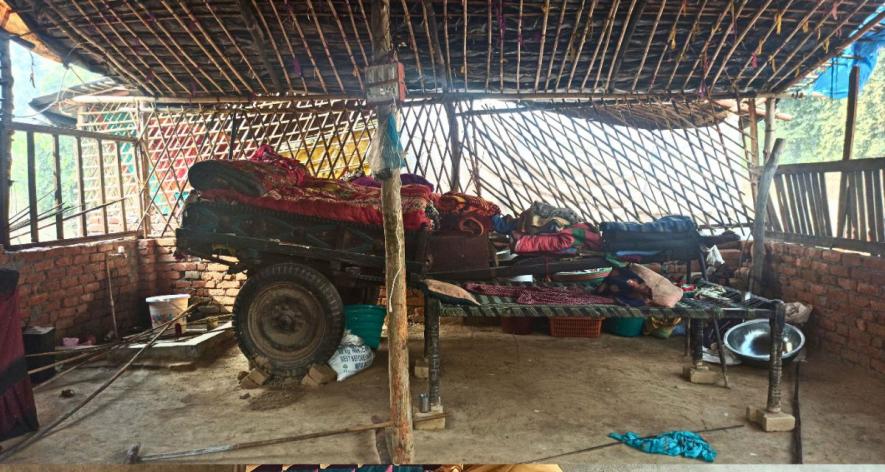
The traditional cart used as a place to store bedding, blankets, and essentials (Photo - Musheera Ashraf, 101Reporters).
“Some rules break due to life’s circumstances,” Sarla adds.
Over time, many of the community members settled in urban areas, setting up small huts on vacant land by railway tracks and roadsides while continuing their trade.
“It became our tradition to move from place to place. So, we could never have a house of our own. But we don’t travel with our families in bullock carts anymore,” Sarla says. The community members build houses themselves while the carts stand as remnants of their nomadic past, now used as a storage facility for the belongings of the families.
Sarla's small dwelling comprises a bed, a television and some iron utensils. “Even this hut is not ours,” she remarks with a wry smile, hinting at the constant threat of eviction. As she steps out, her 4-year-old grandson pleads with Sarla to be taken along. Living by the roadside, Sarla fears for his safety. “There is heavy traffic here. What if he is hit? Pigs roam around. We are forced to live in unhygienic conditions.” She persuades the little boy to stay, bribing him with a one-rupee coin as part of the deal.
A place to call home
In September 2019, NGO Housing and Land Rights Network (HLRN) published a report, ‘Mapping the Marginalized: Delhi's Gadia Lohar Community.’ The report revealed that almost 41% of the settlements lacked access to clean drinking water, 22% to electricity, 75% to healthcare services, 61% to ration shops and nearly half of the settlements surveyed could not use garbage disposal facilities.
Ramesh explains that obtaining permanent land remains their biggest concern. “We will never make any progress while living in these temporary settlements as every season takes its toll on us.” Pointing towards a small cemented building five toilets on one side of the settlement, Ramesh says they were constructed by the Nagar Nigam two years ago. At present, they are shared by the 40 families of the settlement where previously the only choice was open defecation near the stream on the opposite side of the road. “It always worried us and showed that the governing bodies had failed to provide us with basic amenities,” he says.
Danish Khan, an assistant engineer in the construction department of Nagar Nigam Saharanpur, responsible for addressing encroachment cases on roads, acknowledges the dilemma of the Gadia Lohars. “They can live temporarily but not settle permanently,” he sums up.
Khan explains that although the Gadia Lohars’ settlement is considered an encroachment, plans to evict them fail as they tend to return to the area again. According to Nagar Nigam officials, until the Gadia Lohars have their own land, they will continue to live on the roadsides. This poses a challenge for both the community and the local authorities in various cities where the Gadia Lohars have settled.
Danish cites an instance from 2018 in Delhi where 22 Gadia Lohar families were forcefully evicted after their houses were demolished. This is only one of many such instances. In March 2019, even a stay order from the High Court of Delhi did not save a settlement in Khyala from the threat of demolition till the public intervened and a temporary consensus was reached.
Education as a lifeline
The community is tightly knit. As the men mostly stay back to make utensils, they also look after the children while the women are out from early morning till noon to sell the wares. The elderly who are around also watch the children.
Sitting beside a chulha (mud stove), Sunny Thakur (22), an ironsmith wearing a silver kara (bangle) with tattoos adorning his arms, hammers away at white-hot pieces of iron from dawn to dusk. This time, he forges the metal into a spade. Never having had the opportunity to attend school, Sunny began crafting such tools at the age of 12. He laments the waning demand for their handmade wares as mass-produced iron tools and utensils dominate the market. Some community members have resorted to selling plastic tubs alongside their iron goods. Sunny says, “We don't want to lose our customers, but the respect and demand for traditional items has diminished with time.” He justifies the current trend, asking why anyone would choose iron over plastic when the latter comes at a cheaper price.
As the times change, the community recognises the importance of an education. The pradhan Ramesh and his brother’s children are the only ones among the 40 families who have received a senior secondary education. His brother's son Pradeep and daughter Ravina are in the 11th standard, both aspiring to secure good jobs as adults. Exhaling dense smoke from his hookah, Ramesh says, “Our children will either have good jobs or work as ironsmiths. They will not work as labourers or in shops.”
Ramesh is also financially stable. He purchases iron at wholesale price, distributing it to fellow community members who then forge the metal into various utensils. Unlike him, the others cannot afford to send their family members to school as they need more hands at the workshop or to sell the tools. No matter how much a person studies, supporting the family with their work takes precedence.
Most of the girls in the community are married off at an early age, dropping out of government school after puberty and eventually marrying within their own community. They then assist their husbands in ironwork. “The new generation is open to studying to an extent if they want. But I was married as soon as I turned 18,” says a young woman on condition of anonymity. “Ironwork isn’t something we need to learn. We’ve grown up watching it.”
Sunny prefers that the new generation focus on academics. He refers to his friend Shahrukh Kumar, “He got married at 21. Now he has a one-year-old daughter.” Deprived of an education himself, Shahrukh is determined to provide his daughter with that chance. Every winter, he makes Himachal Pradesh his home for six months, renting a room and selling iron tools and utensils there during the season. Shahrukh believes that education is the only way out from the deteriorating condition of their community. He dreams of the day when he will have a house to call his own and a secure environment for his daughter.
“Life is harsh, but we are still creative,” Shahrukh says. The dreariness of life does little to dampen the Lohar spirit, as is evident from the colourful old sarees spread tautly across the roofs of their houses. It is a matter of pride for the community. Shahrukh's wife sits at a sewing machine, stitching the ends of more old sarees together while other family members spread them over the roofs or as curtains to cover their windows.
Noting that their community has a zero percent crime rate, Ramesh says, “We believe in peace though our lives are fraught with difficulties. All we wish for is a permanent area of land that will provide our future generations with a home.” But not at the cost of their ancestry. “We want to change our situation, but we will not compromise on our caste. We are Rajputs, and we seek help as Rajputs,” he states categorically.
(Musheera Ashraf is a Uttar Pradesh-based freelance journalist and a member of 101Reporters, a pan-India network of grassroots reporters.)
Get the latest reports & analysis with people's perspective on Protests, movements & deep analytical videos, discussions of the current affairs in your Telegram app. Subscribe to NewsClick's Telegram channel & get Real-Time updates on stories, as they get published on our website.









